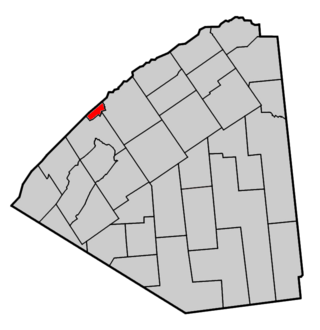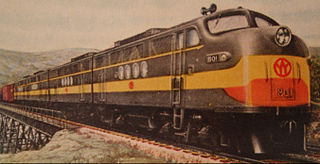
Ransomville is a hamlet located in the Town of Porter in Niagara County, New York, United States. The population was 1,419 at the 2010 census. Portions of the hamlet are also in Town of Wilson and Town of Cambria. Ransomville is north of the City of Niagara Falls and is part of the Buffalo–Niagara Falls Metropolitan Statistical Area.

Liverpool is a lakeside village in Onondaga County, New York, United States. As of the 2020 census, the population was 2,242. The name was adopted from the city of Liverpool in the United Kingdom. The village is on Onondaga Lake, in the western part of the town of Salina and is northwest of Syracuse, of which it is a suburb.

Ogdensburg is a city in St. Lawrence County, New York, United States. The population was 10,064 at the 2020 census. In the late 18th century, European-American settlers named the community after American land owner and developer Samuel Ogden. The city is at the northern border of New York at the mouth of the Oswegatchie River on the south bank of the St. Lawrence River. The only formally designated city in the county, it is located between Massena, New York to the east and Brockville, Ontario to the west.
Cape Vincent is a town in Jefferson County, New York, United States. The population was 2,765 at the 2020 census.

Watertown is a city in and the county seat of Jefferson County, New York, United States. It is approximately 25 miles (40 km) south of the Thousand Islands, along the Black River, about 5 miles (8 km) east of where it flows into Lake Ontario. The city is bordered by the town of Watertown to the south, east, and west, and is served by the Watertown International Airport and the Watertown Daily Times newspaper. In the middle of Watertown lies the Public Square Historic District, which was built in 1805 and listed on the National Register of Historic Places (NRHP) in 1984. Watertown is located 13 miles southwest of the U.S. Army base at Fort Drum; it is the service and shopping destination for personnel there and their families. As of the 2020 United States Census, the city has 24,685 residents, making it the largest city in the North Country.
Lowville is a town in Lewis County, New York, United States. The population was 4,888 at the 2020 census, down from 4,982 in 2010. The town is near the center of the county and is southeast of the city of Watertown. The town of Lowville contains a village also named Lowville, which is the county seat. The town is named after Nicholas Low, an early landowner. Low was of Dutch descent, and had emigrated with his wife and three small children from a rural village outside Amsterdam in 1778. Despite popular folk etymology, the name Lowville has nothing to do with its low elevation or the lowing cattle of the many nearby dairy farms.

Area codes 315 and 680 are telephone area codes of the North American Numbering Plan (NANP) for the north-central area of the U.S. state of New York. Area code 315 was installed as one of the original North American area codes in 1947, while area code 680 was added to the numbering plan area (NPA) in an overlay plan in 2017.

The Rome, Watertown and Ogdensburg Railroad was a railroad that grew, in stages, from Rome, New York to Watertown and then to Ogdensburg, New York and Massena, New York. The original Rome and Watertown Railroad terminated in Cape Vincent, NY on the St. Lawrence River. A branch of the Rome, Watertown and Ogdensburg Railroad, commonly known as "The Hojack Line", operated along the south shore of Lake Ontario, from Oswego, New York to Niagara Falls, New York.

The Ontario Midland Railroad Corporation is an American Class III railroad company operating in western New York. As of September 2022, it became a subsidiary of the Livonia, Avon & Lakeville Railroad (LAL).

New York State Route 3 (NY 3) is a major east–west state highway in New York, in the United States, that connects central New York to the North Country region near the Canada–US border via Adirondack Park. The route extends for 245.88 miles (395.71 km) between its western terminus at an intersection with NY 104A in the Cayuga County town of Sterling and its eastern terminus at a junction with U.S. Route 9 (US 9) in the Clinton County city of Plattsburgh. NY 3 traverses eight counties and is a lakeside roadway from Mexico to Sackets Harbor, a mountainous route in Adirondack Park, and an urban arterial in Fulton, Watertown, and Plattsburgh.

The Portland, Rutland, Oswego and Chicago Railroad was a plan for a railroad between Portland, Maine and Chicago, Illinois, proposed as the first step of a transcontinental railroad. The plans were made by John A. Poor of Portland in the 1860s, but he died in 1871 before they could be finalized.
The Canadian–American League, nicknamed the Can-Am League, was a class C level minor league baseball circuit which ran from 1936 through 1951, with a three-year break during World War II.

The New York, Ontario and Western Railway, commonly known as the O&W or NYO&W, was a regional railroad founded in 1868. The last train ran from Norwich, New York, to Middletown, New York, in 1957, after which it was ordered liquidated by a U.S. bankruptcy judge. It was the first Class I U.S. railroad to be abandoned in its entirety.

The Great Lakes Seaway Trail, formerly named and commonly known as the Seaway Trail, is a 518-mile (834 km) National Scenic Byway in the northeastern United States, mostly contained in New York but with a small segment in Pennsylvania. The trail consists of a series of designated roads and highways that travel along the Saint Lawrence Seaway—specifically, Lake Erie, the Niagara River, Lake Ontario, and the Saint Lawrence River. It begins at the Ohio state line in rural Erie County, Pennsylvania, and travels through several cities and villages before ending at the Seaway International Bridge northeast of the village of Massena in St. Lawrence County, New York. It is maintained by the non-profit Seaway Trail, Inc.
The St. Lawrence Subdivision is a railroad line owned by CSX Transportation in the U.S. state of New York. The line runs from Syracuse, New York, north to Massena, New York, along a former New York Central Railroad line. At its south end, it meets the Syracuse Terminal Subdivision; its north end is at the south end of the Montreal Subdivision. Along the way it junctions with the Fulton Subdivision at Woodard, New York,.
The Syracuse Northern Railroad, incorporated in 1868 and opened on November 9, 1871, drew trade from Liverpool to Syracuse, New York. The line had routes to Watertown, New York, and in 1875, the road was extended to Pulaski and Lacona.
The Syracuse, Phoenix and Oswego Railroad was chartered on November 29, 1871, and had a route from Woodard, located north of Syracuse, New York, to Fulton, New York, a distance of 17.11 miles (27.54 km). They merged with the Syracuse Northwestern Railroad on June 10, 1875, and incorporated as Syracuse, Phoenix and Oswego Railway on February 16, 1885.
The Syracuse Northwestern Railroad was established in 1874 to construct a railroad from Woodard to Haymarket Square in Syracuse, New York. The company was consolidated under the Syracuse, Phoenix and Oswego Railroad in 1875 and was sold under a judgement in 1885 under the name Syracuse, Phoenix and Oswego Railway.
The Ontario Eastern Railroad was a shortline freight railroad formed in 1981 to operate a portion of the former Rome, Watertown and Ogdensburg Railroad from Ogdensburg to DeKalb Junction. The primary freight customer was a paper mill located in Ogdensburg. When the mill shut down in 1985, the railroad ended operations. Formal abandonment followed in 1987 and the tracks were scrapped. The ONER was officially dissolved in 1992.












